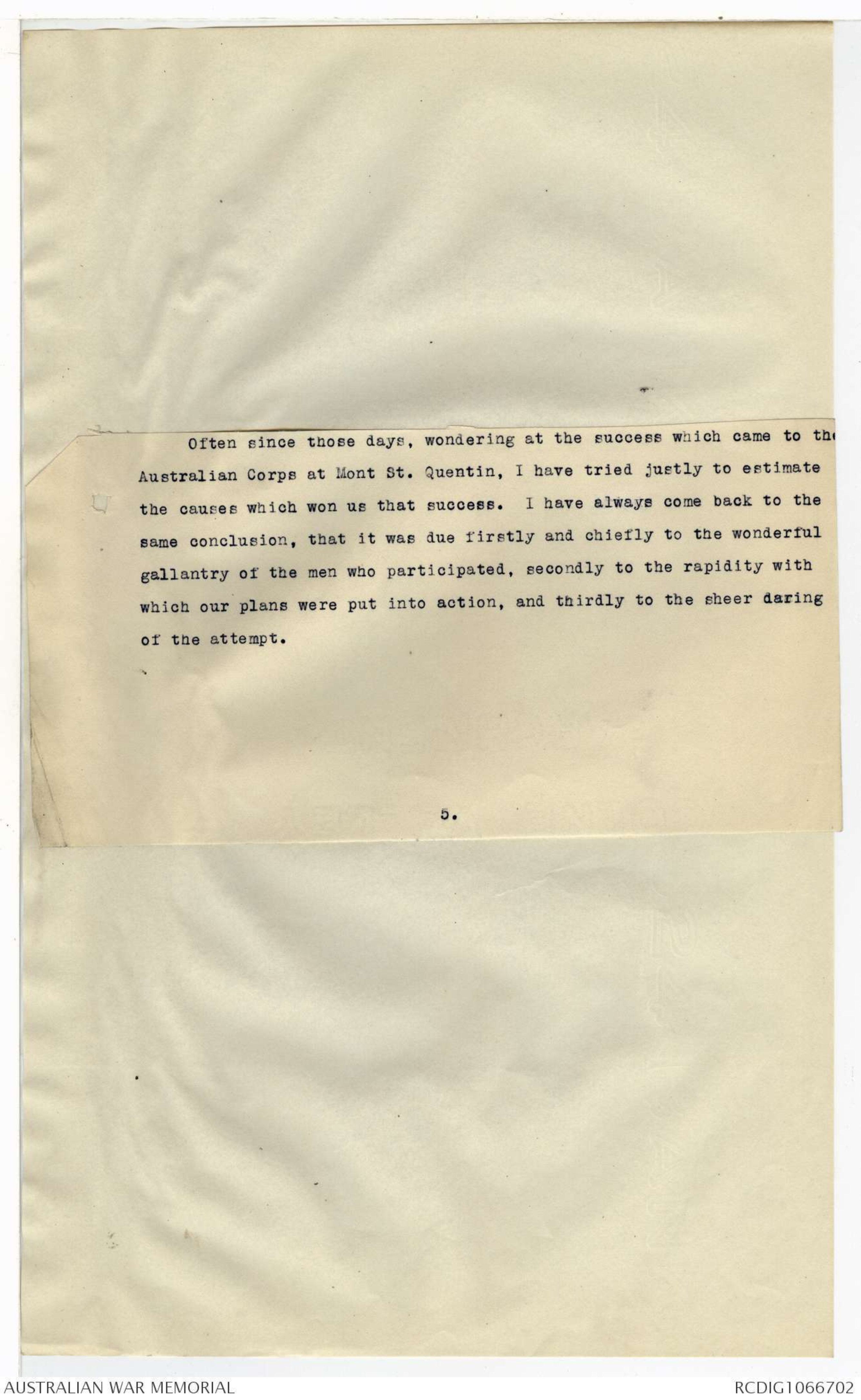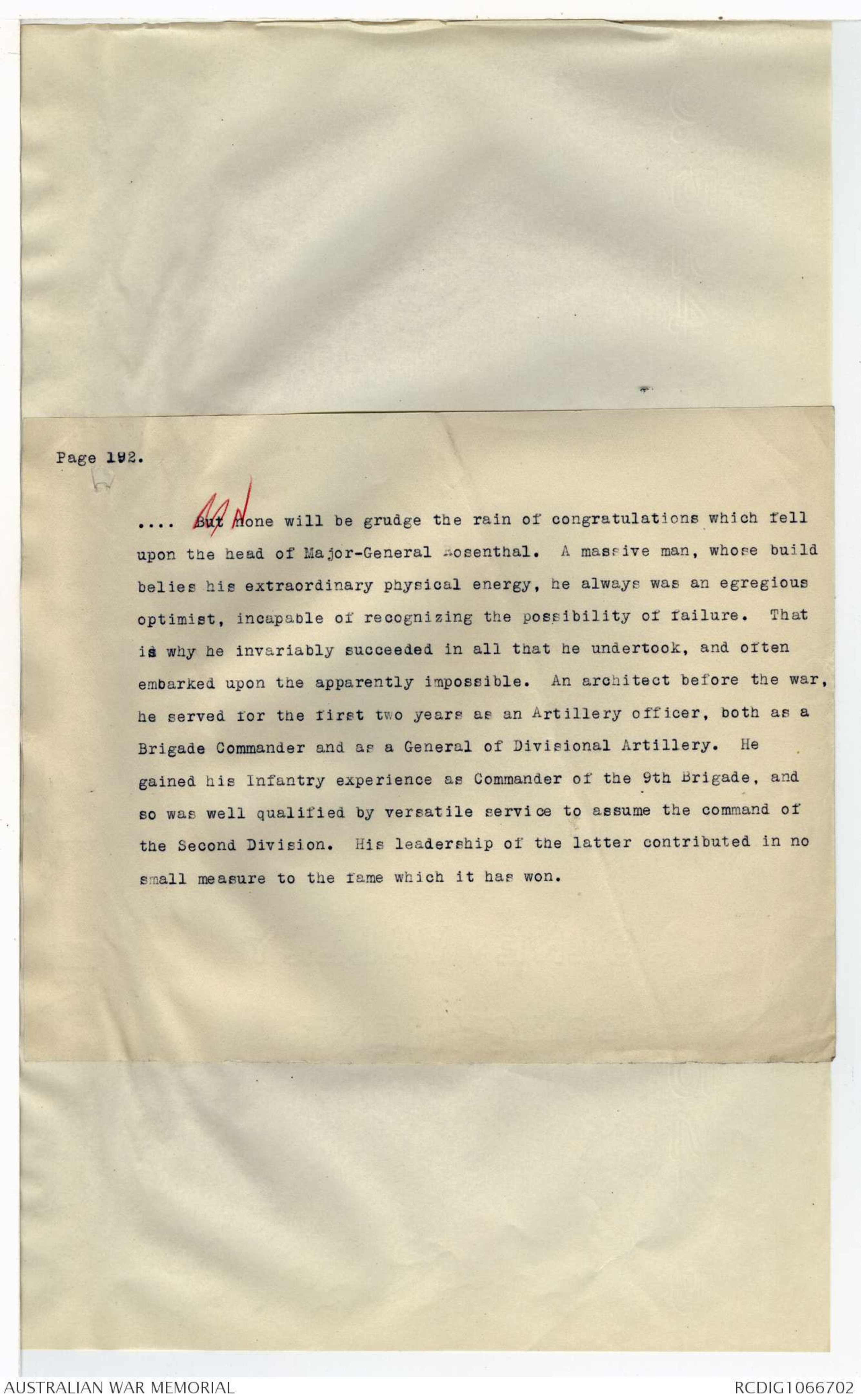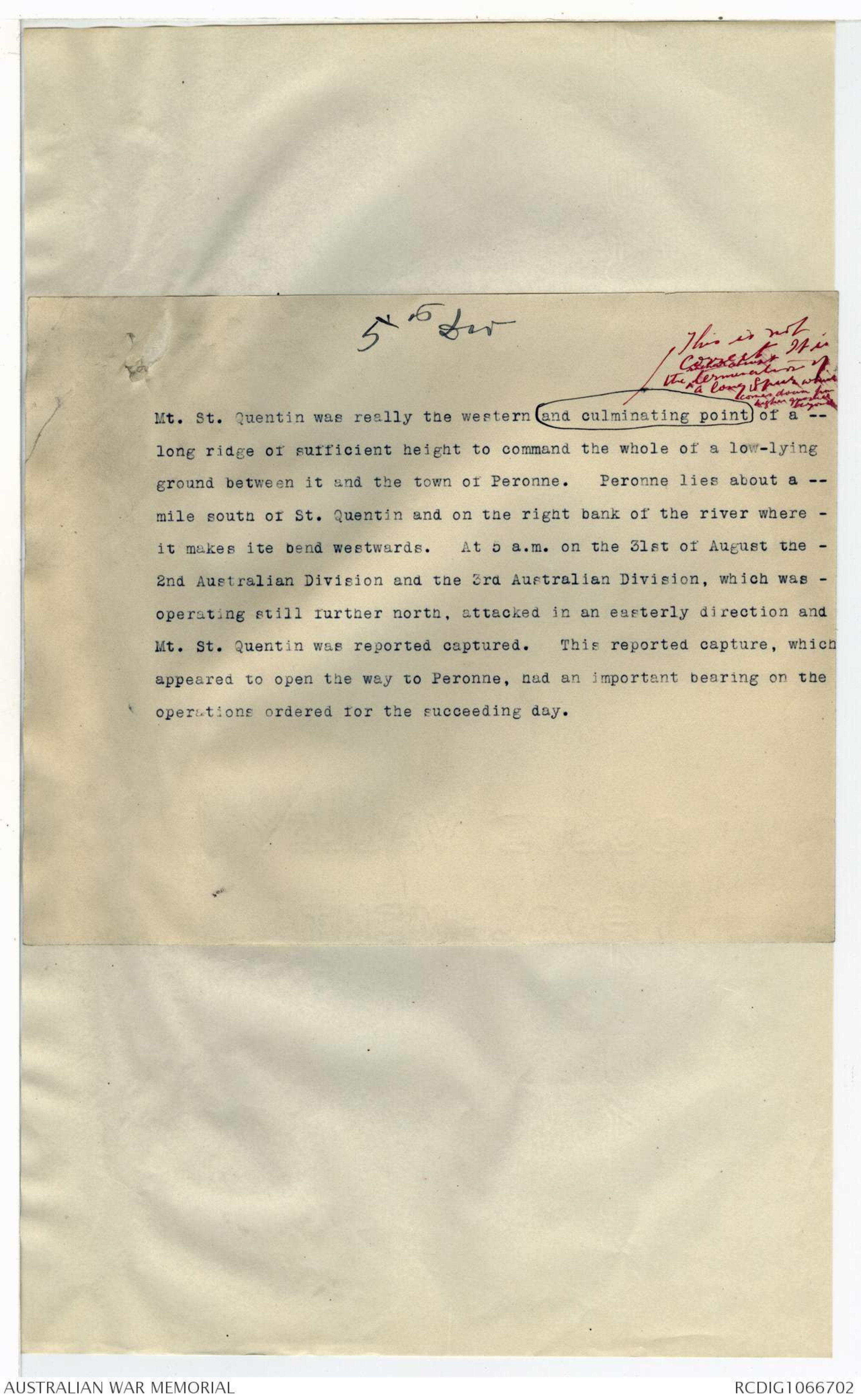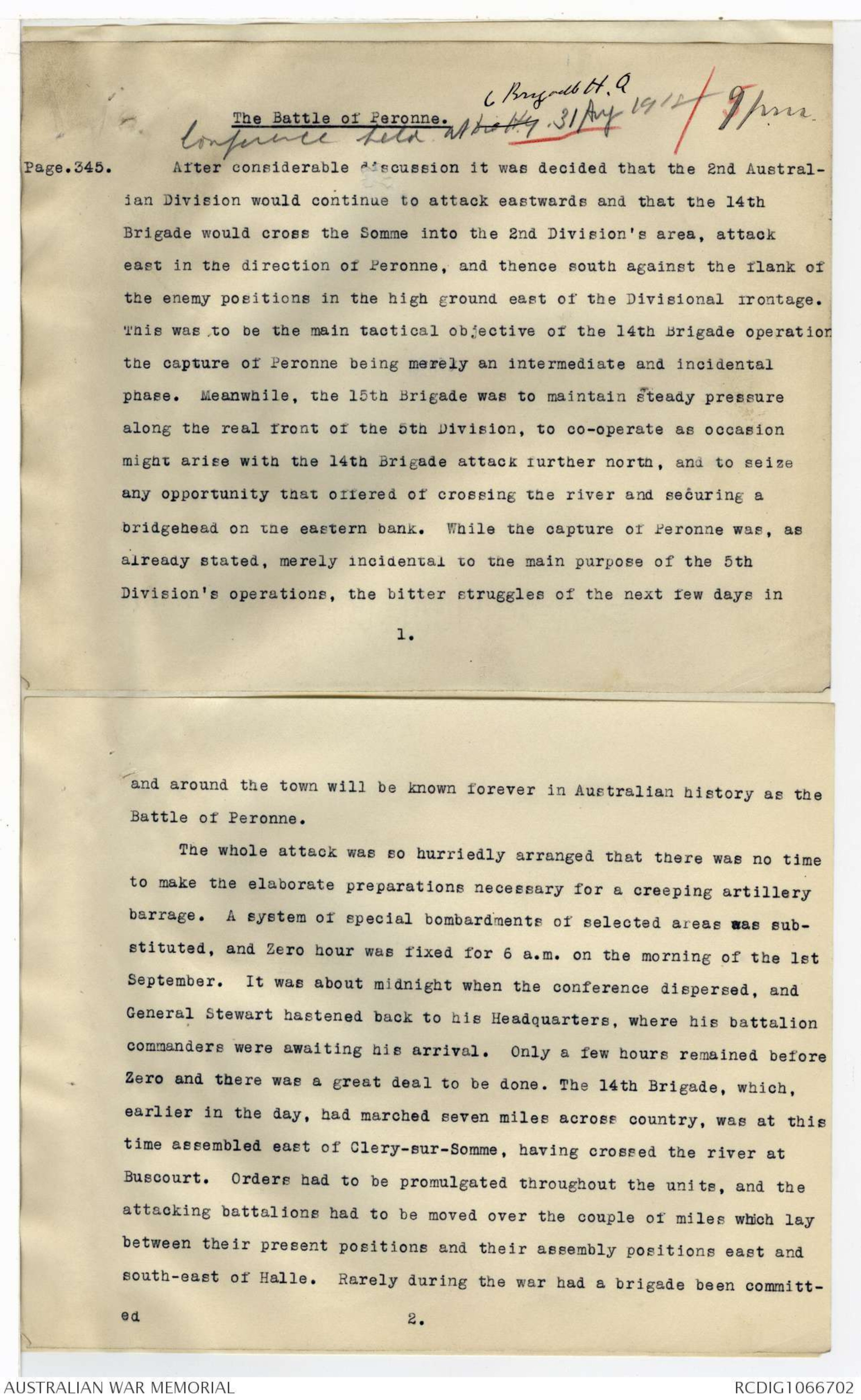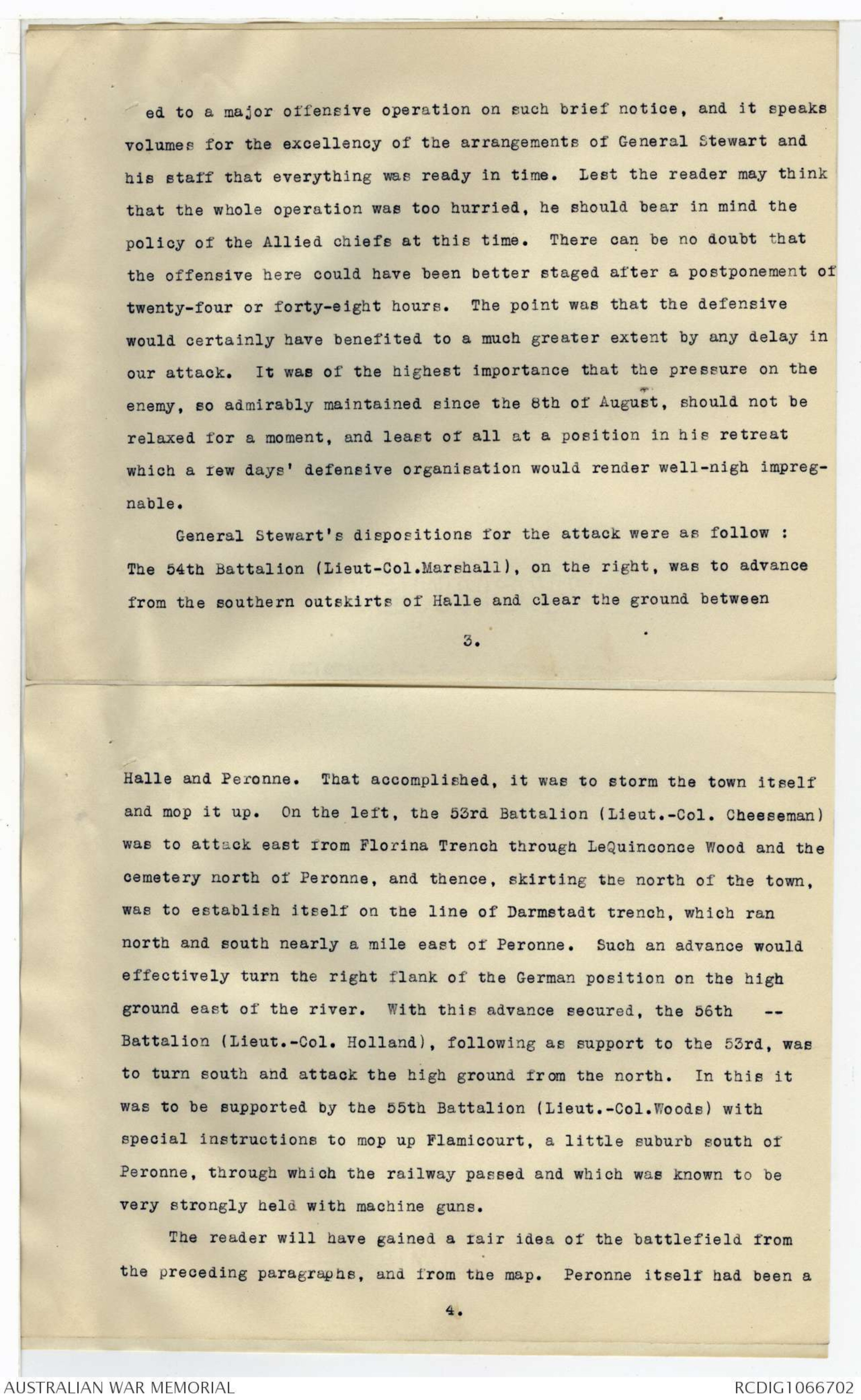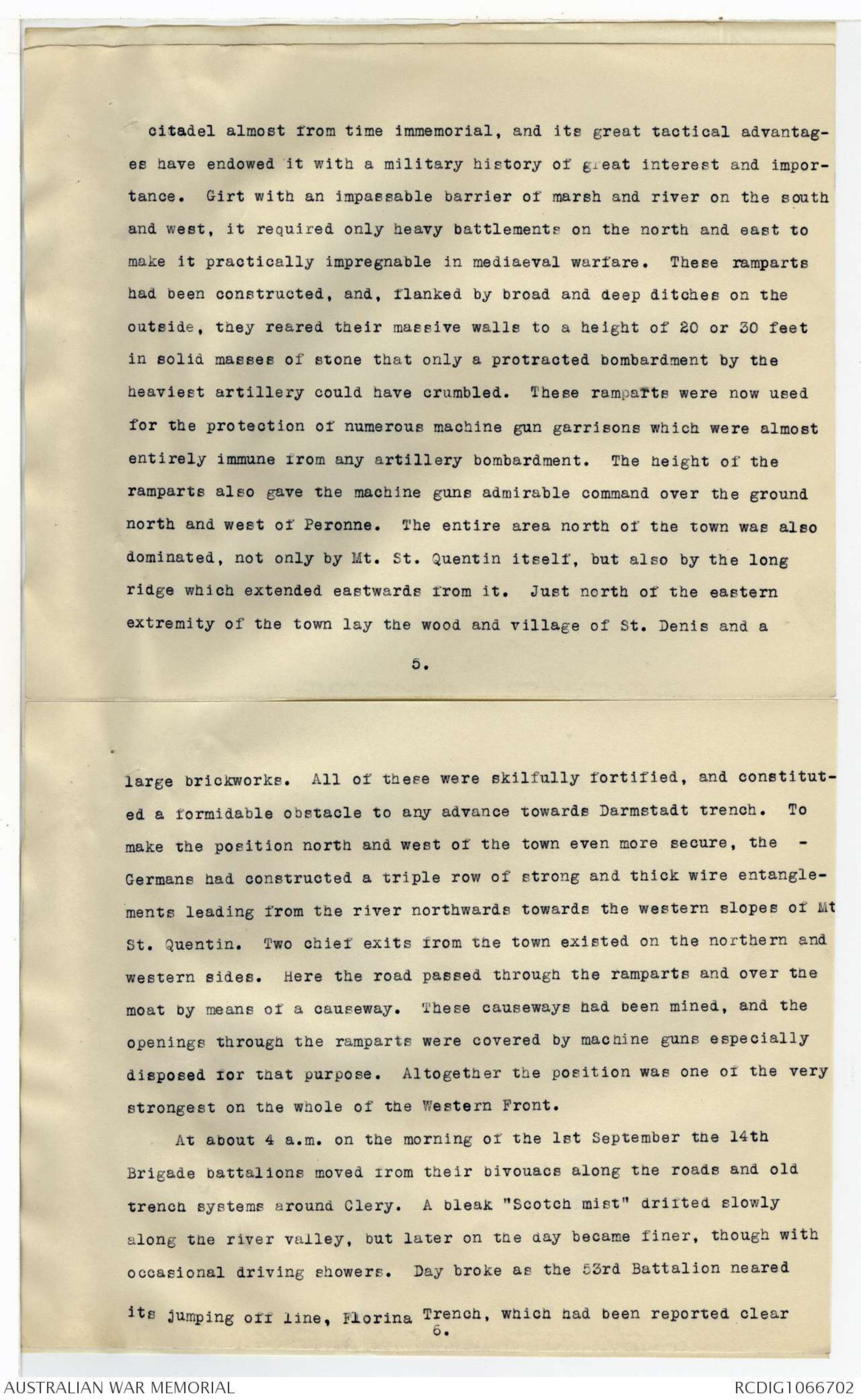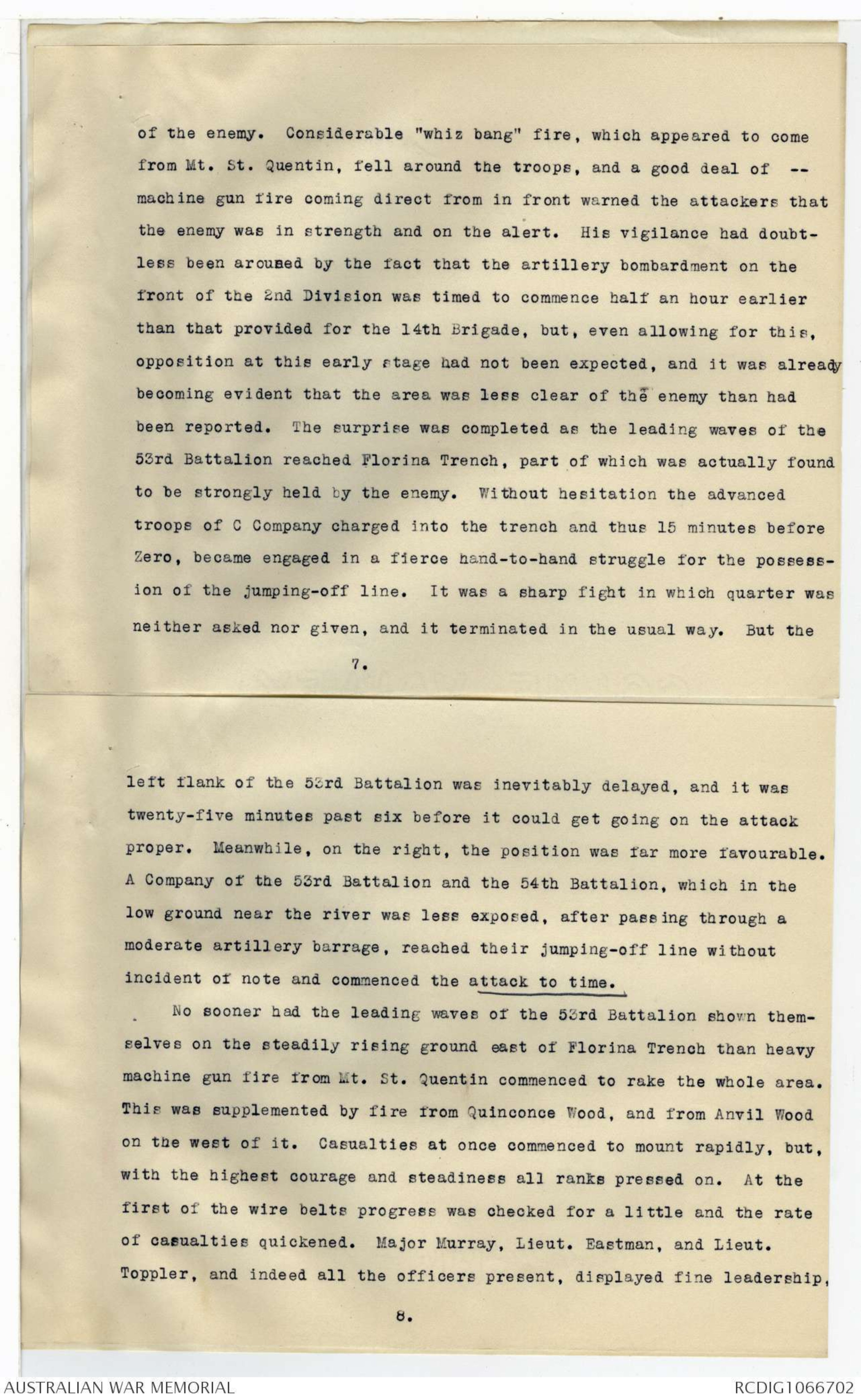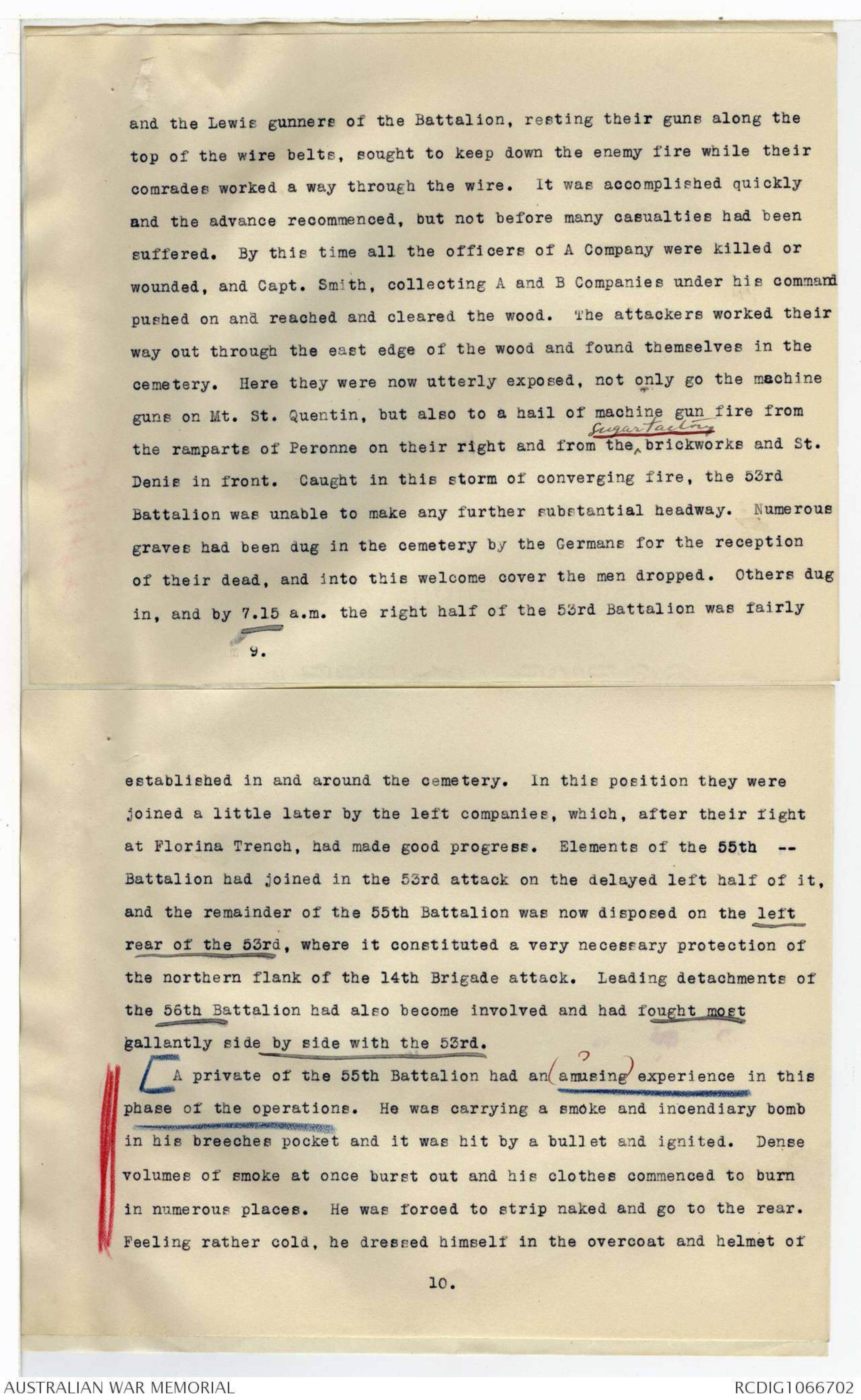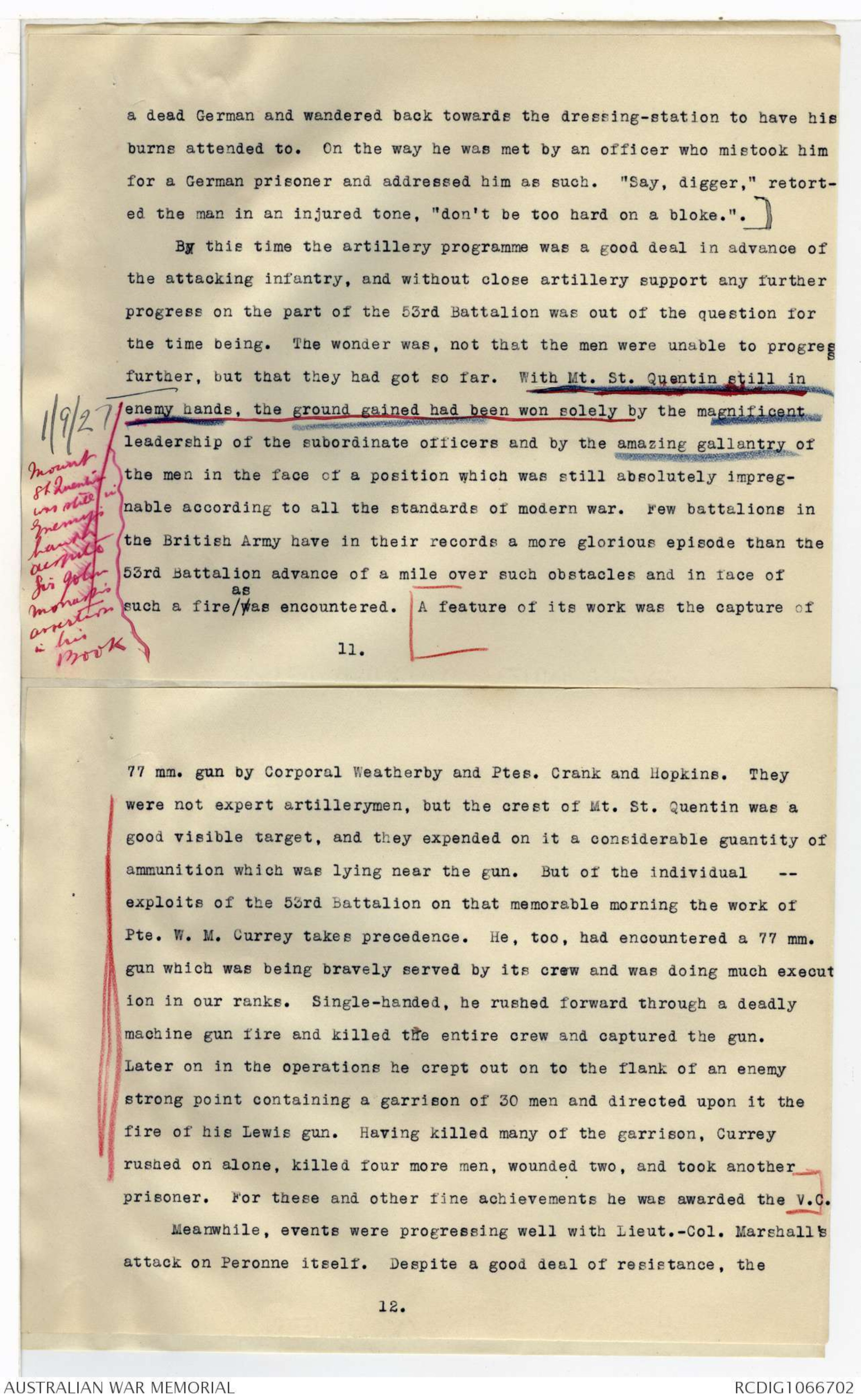Charles E W Bean, Diaries, AWM38 3DRL 606/266/1 - September 1918 - Part 5

At its conclusion we emerged complete masters of the situation.
Mont St. Quentin, the Bouchavesnes spur, the large town of Peronne,
and the high ground overlooking it from the east and north-east, were
in our possession. A wide breach had been driven into the line of
defence which the enemy had endeavoured to establish on the series of
heights lying to the east of the Somme and of the Canal du Nord.
From the edges of this breach, the flanks of that portion of his
line which were still intact were being threatened with envelopment.
For him there was nothing for it, but finally to abandon the line
of the Somme, and to resume his retreat helter-skelter to the hoped-for
secure protection of the great Hindenburg Line.
often since those days, wondering at the success which came to the
Australian Corps at Mont St. Quentin, I have tried justly to estimate
the causes which won us that success. I have always come back to the
same conclusion, that it was due firstly and chiefly to the wonderful
gallantry of the men who participated, secondly to the rapidity with
which our plans were put into action, and thirdly to the sheer daring
of the attempt.
5.
Page 192.
.... But None will be grudge the rain of congratulations which fell
upon the head of Major-General Rosenthal. A massive man, whose build
belies his extraordinary physical energy, he always was an egregious
optimist, incapable of recognizing the possibility of failure. That
is why he invariably succeeded in all that he undertook, and often
embarked upon the apparently impossible. An architect before the war,
he served for the first two years as an Artillery officer, both as a
Brigade Commander and as a General of Divisional Artillery. He
gained his Infantry experience as Commander of the 9th Brigade, and
so was well qualified by versatile service to assume the command of
the Second Division. His leadership of the latter contributed in no
small measure to the fame which it has won.
5th ber
Mt. St. Quentin was really the western (and culminating point ∧ This is not correct It is the termination of a long stream which comes does from higher ground beyond )of a --
long ridge of sufficient height to command the whole of a low-lying
ground between it and the town of Peronne. Peronne lies about a --
mile south of St. Quentin and on the right bank of the river where -
it makes ite bend westwards. At 5 a.m. on the 31st of August the -
2nd Australian Division and the 3rd Australian Division, which was -
operating still further north, attacked in an easterly direction and
Mt. St. Quentin was reported captured. This reported capture, which
appeared to open the way to Peronne, nad an important bearing on the
operations ordered for the succeeding day.
Page.345.
C Brigade H.Q.
Conference held wt bralty ^ 31 Aug 1912/ 9 pass
The Battle of Peronne.
After considerable discussion it was decided that the 2nd Australian
Division would continue to attack eastwards and that the l4th
Brigade would cross the Somme into the 2nd Division's area, attack
east in the direction of Peronne, and thence south against the flank of
the enemy positions in the high ground east of the Divisional frontage.
This was to be the main tactical objective of the l4th Brigade operation
the capture of Peronne being merely an intermediate and incidental
phase. Meanwhile, the 15th Brigade was to maintain steady pressure
along the real front of the 5th Division, to co-operate as occasion
might arise with the l4th Brigade attack further north, and to seize
any opportunity that offered of crossing the river and securing a
bridgehead on the eastern bank. While the capture of Peronne was, as
already stated, merely incidental to the main purpose of the 5th
Division's operations, the bitter struggles of the next few days in
1.
and around the town will be known forever in Australian history as the
Battle of Peronne.
The whole attack was so hurriedly arranged that there was no time
to make the elaborate preparations necessary for a creeping artillery
barrage. A system of special bombardments of selected areas was substituted,
and Zero hour was fixed for 6 a.m. on the morning of the 1st
September. It was about midnight when the conference dispersed, and
General Stewart hastened back to his Headquarters, where his battalion
commanders were awaiting his arrival. Only a few hours remained before
Zero and there was a great deal to be done. The l4th Brigade, which,
earlier in the day, had marched seven miles across country, was at this
time assembled east of Clery-sur-Somme, having crossed the river at
Buscourt. Orders had to be promulgated throughout the units, and the
attacking battalions had to be moved over the couple of miles which lay
between their present positions and their assembly positions east and
south-east of Halle. Rarely during the war had a brigade been committ-
ed
2.
ed to a major offensive operation on such brief notice, and it speaks
volumes for the excellency of the arrangements of General Stewart and
his staff that everything was ready in time. Lest the reader may think
that the whole operation was too hurried, he should bear in mind the
policy of the Allied chiefs at this time. There can be no doubt that
the offensive here could have been better staged after a postponement of
twenty four or forty-eight hours. The point was that the defensive
would certainly have benefited to a much greater extent by any delay in
our attack. It was of the highest importance that the pressure on the
enemy, so admirably maintained since the 8th of August, should not be
relaxed for a moment, and least of all at a position in his retreat
which a few days' defensive organisation would render well-nigh impregnable.
General Stewart's dispositions for the attack were as follow :
The 54th Battalion (Lieut-Col. Marshall), on the right, was to advance
from the southern outskirts of Halle and clear the ground between
3.
Halle and Peronne. That accomplished, it was to storm the town itself
and mop it up. On the left, the 53rd Battalion (Lieut.-Col. Cheeseman)
was to attack east from Florina Trench through LeQuinconce Wood and the
cemetery north of Peronne, and thence, skirting the north of the town,
was to establish itself on the line of Darmstadt trench, which ran
north and south nearly a mile east of Peronne. Such an advance would
effectively turn the right flank of the German position on the high
ground east of the river. With this advance secured, the 56th
-
Battalion (Lieut.-Col. Holland), following as support to the 53rd, was
to turn south and attack the high ground from the north. In this it
was to be supported by the 55th Battalion (Lieut.-Col.Woods) with
special instructions to mop up Flamicourt, a little suburb south of
Peronne, through which the railway passed and which was known to be
very strongly held with machine guns.
The reader will have gained a fair idea of the battlefield from
the preceding paragraphs, and from the map. Peronne itself had been a
citadel almost from time immemorial, and its great tactical advantages
have endowed it with a military history of great interest and importance.
Girt with an impassable barrier of marsh and river on the south
and west, it required only heavy battlements on the north and east to
make it practically impregnable in mediaeval warfare. These ramparts
had been constructed, and, flanked by broad and deep ditches on the
outside, they reared their massive walls to a height of 20 or 30 feet
in solid masses of stone that only a protracted bombardment by the
heaviest artillery could have crumbled. These ramparts were now used
for the protection of numerous machine gun garrisons which were almost
entirely immune from any artillery bombardment. The height of the
ramparts also gave the machine guns admirable command over the ground
north and west of Peronne. The entire area north of the town was also
dominated, not only by Mt. St. Quentin itself, but also by the long
ridge which extended eastwards from it. Just north of the eastern
extremity of the town lay the wood and village of St. Denis and a
5.
large brickworks. All of these were skilfully fortified, and constitut-
ed a formidable obstacle to any advance towards Darmstadt trench. To
make the position north and west of the town even more secure, the -
Germans had constructed a triple row of strong and thick wire entangle-
ments leading from the river northwards towards the western slopes of Mt
St. Quentin. Two chief exits from the town existed on the northern and
western sides. Here the road passed through the ramparts and over the
moat by means of a causeway. These causeways had been mined, and the
openings through the ramparts were covered by machine guns especially
disposed for that purpose. Altogether the position was one of the very
strongest on the whole of the Western Front.
At about 4 a.m. on the morning of the 1st September the 14th
Brigade battalions moved from their bivouacs along the roads and old
trench systems around Clery. A bleak "Scotch mist" drifted slowly
along the river valley, but later on the day became finer, though with
occasional driving showers. Day broke as the 53rd Battalion neared
its jumping off line, Florina Trench, which had been reported clear
6.
of the enemy. Considerable "whiz bang" fire, which appeared to come
from Mt. St. Quentin, fell around the troops, and a good deal of --
machine gun fire coming direct from in front warned the attackers that
the enemy was in strength and on the alert. His vigilance had doubt-
less been aroused by the fact that the artillery bombardment on the
front of the 2nd Division was timed to commence half an hour earlier
than that provided for the 14th Brigade, but, even allowing for this,
opposition at this early stage had not been expected, and it was already
becoming evident that the area was less clear of the enemy than had
been reported. The surprise was completed as the leading waves of the
53rd Battalion reached Florina Trench, part of which was actually found
to be strongly held by the enemy. Without hesitation the advanced
troops of C Company charged into the trench and thus 15 minutes before
Zero, became engaged in a fierce hand-to-hand struggle for the possess-
ion of the jumping-off line. It was a sharp fight in which quarter was
neither asked nor given, and it terminated in the usual way. But the
7.
left flank of the 53rd Battalion was inevitably delayed, and it was
twenty-five minutes past six before it could get going on the attack
proper. Meanwhile, on the right, the position was far more favourable.
A Company of the 53rd Battalion and the 54th Battalion, which in the
low ground near the river was less exposed, after passing through a
moderate artillery barrage, reached their jumping-off line without
incident of note and commenced the attack to time.
No sooner had the leading waves of the 53rd Battalion shown them-
selves on the steadily rising ground east of Florina Trench than heavy
machine gun fire from Mt. St. Quentin commenced to rake the whole area.
This was supplemented by fire from Quinconce Wood, and from Anvil Wood
on the west of it. Casualties at once commenced to mount rapidly, but,
with the highest courage and steadiness all ranks pressed on. At the
first of the wire belts progress was checked for a little and the rate
of casualties quickened. Major Murray, Lieut. Eastman, and Lieut.
Toppler, and indeed all the officers present, displayed fine leadership,
8.
and the Lewis gunners of the Battalion, resting their guns along the
top of the wire belts, sought to keep down the enemy fire while their
comrades worked a way through the wire. It was accomplished quickly
and the advance recommenced, but not before many casualties had been
suffered. By this time all the officers of A Company were killed or
wounded, and Capt. Smith, collecting A and B Companies under his command
pushed on and reached and cleared the wood. The attackers worked their
way out through the east edge of the wood and found themselves in the
cemetery. Here they were now utterly exposed, not only go the machine
guns on Mt. St. Quentin, but also to a hail of machine gun fire from
the ramparts of Peronne on their right and from the, ^ sugar factory brickworks and St.
Denis in front. Caught in this storm of converging fire, the 53rd
Battalion was unable to make any further substantial headway. Numerous
graves had been dug in the cemetery by the Germans for the reception
of their dead, and into this welcome cover the men dropped. Others dug
in, and by 7.15 a.m. the right half of the 53rd Battalion was fairly
9.
established in and around the cemetery. In this position they were
joined a little later by the left companies, which, after their fight
at Florina Trench, had made good progress. Elements of the 55th -
Battalion had joined in the 53rd attack on the delayed left half of it,
and the remainder of the 55th Battalion was now disposed on the left
rear of the 53rd, where it constituted a very necessary protection of
the northern flank of the 14th Brigade attack. Leading detachments of
the 56th Battalion had also become involved and had fought most
gallantly side by side with the 53rd.
A private of the 55th Battalion had an(amusing experience in this
phase of the operations. He was carrying a smoke and incendiary bomb
in his breeches pocket and it was hit by a bullet and ignited. Dense
volumes of smoke at once burst out and his clothes commenced to burn
in numerous places. He was forced to strip naked and go to the rear.
Feeling rather cold, he dressed himself in the overcoat and helmet of
10.
a dead German and wandered back towards the dressing-station to have his
burns attended to. On the way he was met by an officer who mistook him
for a German prisoner and addressed him as such. "Say, digger," retort-
ed the man in an injured tone, "don’t be too hard on a bloke.".
By this time the artillery programme was a good deal in advance of
the attacking infantry, and without close artillery support any further
progress on the part of the 53rd Battalion was out of the question for
the time being. The wonder was, not that the men were unable to progress
further, but that they had got so far. With Mt. St. Quentin still in
enemy hands. the ground gained had been won solely by the magnificent.
leadership of the subordinate officers and by the amazing gallantry of
the men in the face of a position which was still absolutely impregnable
according to all the standards of modern war. Few battalions in
the British Army have in their records a more glorious episode than the
53rd Battalion advance of a mile over such obstacles and in face of
such a fire/was encountered. A feature of its work was the capture of
[* 1/9/27 Mount St. Quentin was still in enemy hands despite Sir John Monash's assertions in his Book*]
11.
77 mm. gun by Corporal Weatherby and Ptes. Crank and Hopkins. They
were not expert artillerymen, but the crest of Mt. St. Quentin was a
good visible target, and they expended on it a considerable guantity of
ammunition which was lying near the gun. But of the individual--
exploits of the 53rd Battalion on that memorable morning the work of
Pte. W. M. Currey takes precedence. He, too, had encountered a 77 mm.
gun which was being bravely served by its crew and was doing much execution
in our ranks. Single-handed, he rushed forward through a deadly
machine gun fire and killed the entire crew and captured the gun.
Later on in the operations he crept out on to the flank of an enemy
strong point containing a garrison of 30 men and directed upon it the
fire of his Lewis gun. Having killed many of the garrison, Currey
rushed on alone, killed four more men, wounded two, and took another
prisoner. For these and other fine achievements he was awarded the V.C.
Meanwhile, events were progressing well with Lieut.-Col. Marshall's
attack on Peronne itself. Despite a good deal of resistance, the
12.
 Sam scott
Sam scottThis transcription item is now locked to you for editing. To release the lock either Save your changes or Cancel.
This lock will be automatically released after 60 minutes of inactivity.
